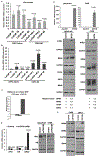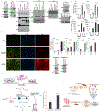BRN4 Is a Novel Driver of Neuroendocrine Differentiation in Castration-Resistant Prostate Cancer and Is Selectively Released in Extracellular Vesicles with BRN2
- PMID: 31371344
- PMCID: PMC6825556
- DOI: 10.1158/1078-0432.CCR-19-0498
BRN4 Is a Novel Driver of Neuroendocrine Differentiation in Castration-Resistant Prostate Cancer and Is Selectively Released in Extracellular Vesicles with BRN2
Abstract
Purpose:
Neuroendocrine prostate cancer (NEPC), an aggressive variant of castration-resistant prostate cancer (CRPC), often emerges after androgen receptor-targeted therapies such as enzalutamide or de novo, via trans-differentiation process of neuroendocrine differentiation. The mechanistic basis of neuroendocrine differentiation is poorly understood, contributing to lack of effective predictive biomarkers and late disease recognition. The purpose of this study was to examine the role of novel proneural
Results: We identify for the first time that: (i) BRN4 is amplified and overexpressed in NEPC clinical samples and that BRN4 overexpression drives neuroendocrine differentiation via its interplay with BRN2, a TF that was previously implicated in NEPC; (ii) BRN4 and BRN2 mRNA are actively released in prostate cancer EVs upon neuroendocrine differentiation induction; and (iii) enzalutamide treatment augments release of BRN4 and BRN2 in prostate cancer EVs, promoting neuroendocrine differentiation induction.
Conclusions: Our study identifies a novel TF that drives NEPC and suggests that as adaptive mechanism to enzalutamide treatment, prostate cancer cells express and secrete BRN4 and BRN2 in EVs that drive oncogenic reprogramming of prostate cancer cells to NEPC. Importantly, EV-associated BRN4 and BRN2 are potential novel noninvasive biomarkers to predict neuroendocrine differentiation in CRPC.
©2019 American Association for Cancer Research.
Conflict of interest statement
Figures






Similar articles
-
The Master Neural Transcription Factor BRN2 Is an Androgen Receptor-Suppressed Driver of Neuroendocrine Differentiation in Prostate Cancer.Cancer Discov. 2017 Jan;7(1):54-71. doi: 10.1158/2159-8290.CD-15-1263. Epub 2016 Oct 26. Cancer Discov. 2017. PMID: 27784708
-
MUC1-C regulates lineage plasticity driving progression to neuroendocrine prostate cancer.Nat Commun. 2020 Jan 17;11(1):338. doi: 10.1038/s41467-019-14219-6. Nat Commun. 2020. PMID: 31953400 Free PMC article.
-
Identification of Novel Diagnosis Biomarkers for Therapy-Related Neuroendocrine Prostate Cancer.Pathol Oncol Res. 2021 Sep 27;27:1609968. doi: 10.3389/pore.2021.1609968. eCollection 2021. Pathol Oncol Res. 2021. PMID: 34646089 Free PMC article.
-
Molecular model for neuroendocrine prostate cancer progression.BJU Int. 2018 Oct;122(4):560-570. doi: 10.1111/bju.14207. Epub 2018 Apr 24. BJU Int. 2018. PMID: 29569310 Review.
-
Dependence on MUC1-C in Progression of Neuroendocrine Prostate Cancer.Int J Mol Sci. 2023 Feb 13;24(4):3719. doi: 10.3390/ijms24043719. Int J Mol Sci. 2023. PMID: 36835130 Free PMC article. Review.
Cited by
-
Exosomes That Have Different Cellular Origins Followed by the Impact They Have on Prostate Tumor Development in the Tumor Microenvironment.Cancer Rep (Hoboken). 2024 Sep;7(9):e70001. doi: 10.1002/cnr2.70001. Cancer Rep (Hoboken). 2024. PMID: 39229670 Free PMC article. Review.
-
Prostate cancer-derived small extracellular vesicle proteins: the hope in diagnosis, prognosis, and therapeutics.J Nanobiotechnology. 2023 Dec 14;21(1):480. doi: 10.1186/s12951-023-02219-0. J Nanobiotechnology. 2023. PMID: 38093355 Free PMC article. Review.
-
SYT4 binds to SNAP25 to facilitate exosomal secretion and prostate cancer enzalutamide resistance.Cancer Sci. 2024 Aug;115(8):2630-2645. doi: 10.1111/cas.16239. Epub 2024 Jun 18. Cancer Sci. 2024. PMID: 38889208 Free PMC article.
-
Small extracellular vesicles modulated by αVβ3 integrin induce neuroendocrine differentiation in recipient cancer cells.J Extracell Vesicles. 2020 May 24;9(1):1761072. doi: 10.1080/20013078.2020.1761072. J Extracell Vesicles. 2020. PMID: 32922691 Free PMC article.
-
Novel, non-invasive markers for detecting therapy induced neuroendocrine differentiation in castration-resistant prostate cancer patients.Sci Rep. 2021 Apr 15;11(1):8279. doi: 10.1038/s41598-021-87441-2. Sci Rep. 2021. PMID: 33859239 Free PMC article.
References
Publication types
MeSH terms
Substances
Grants and funding
LinkOut - more resources
Full Text Sources
Other Literature Sources
Miscellaneous

